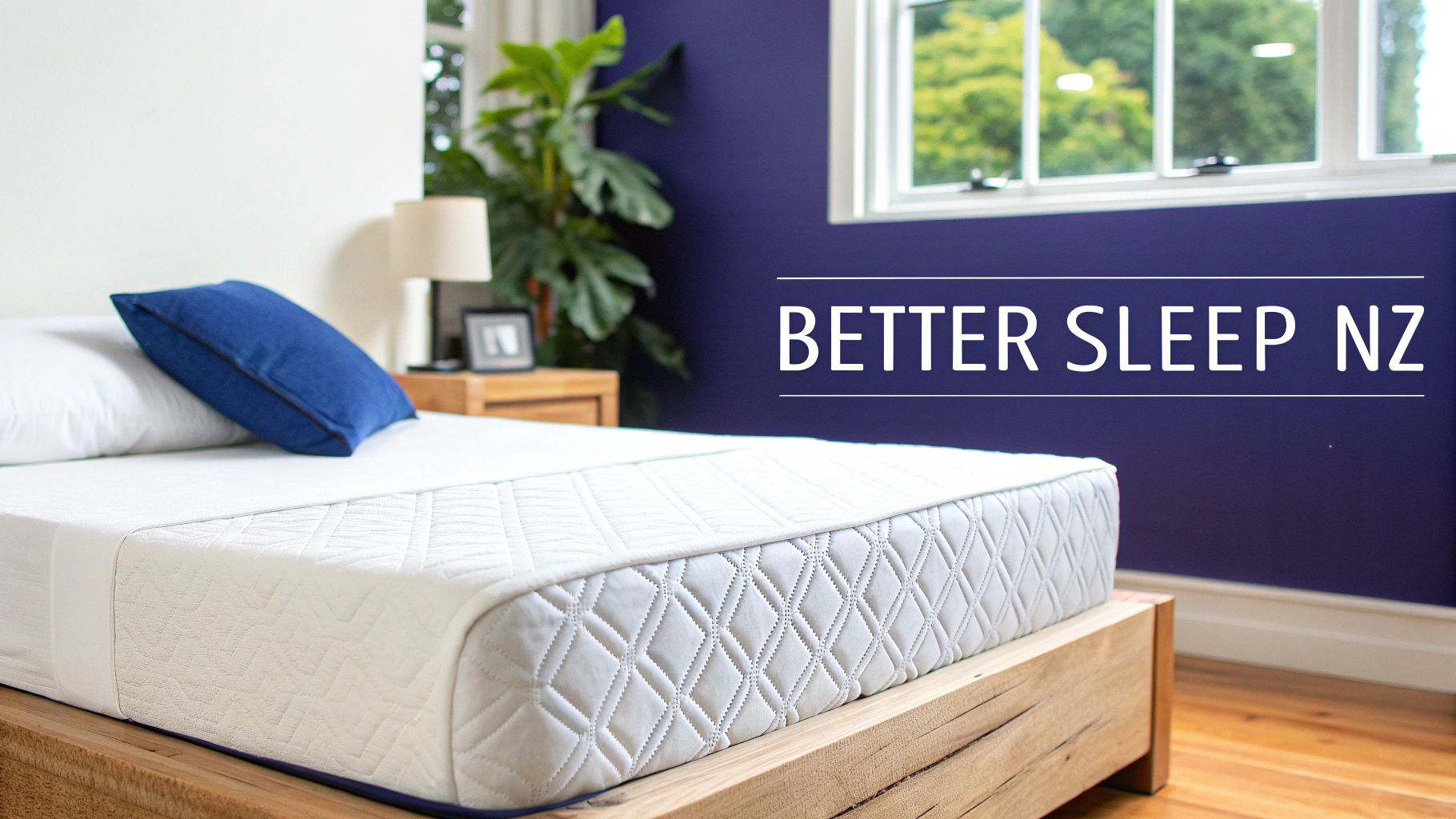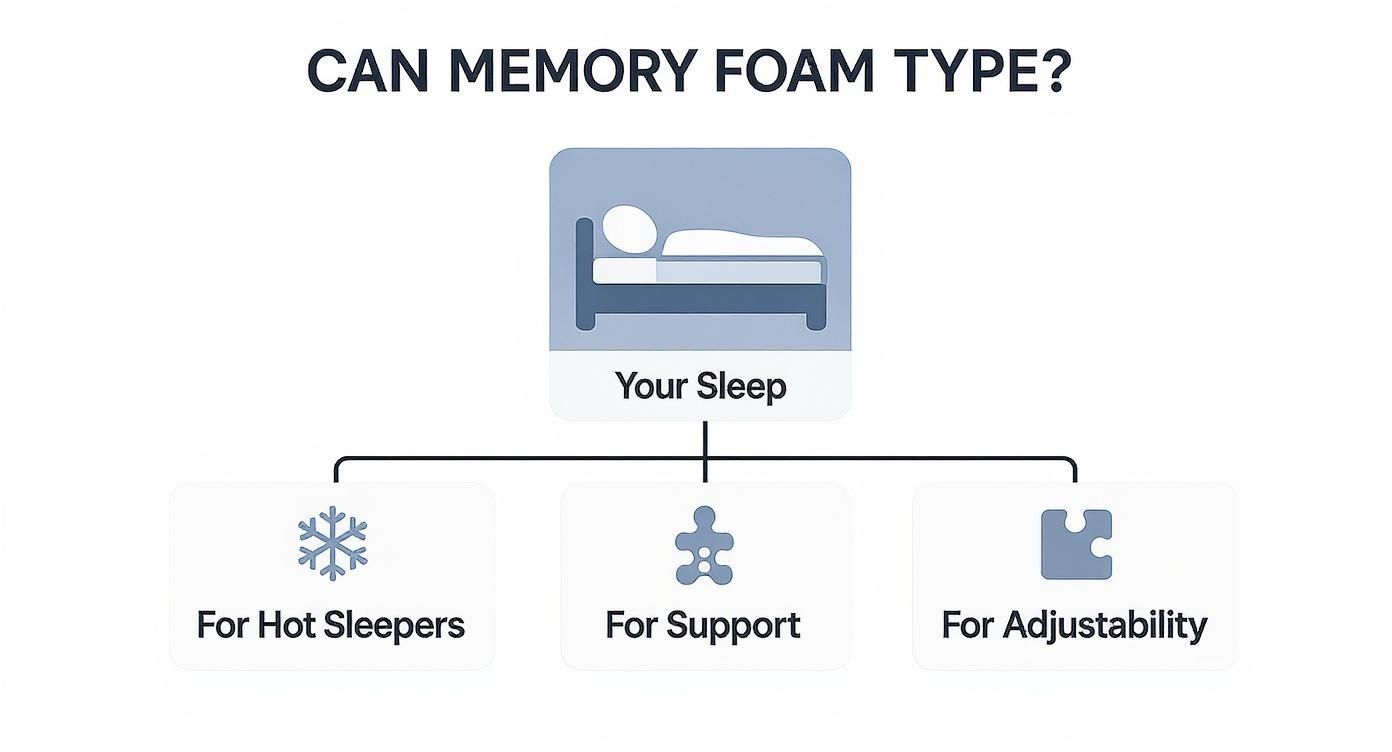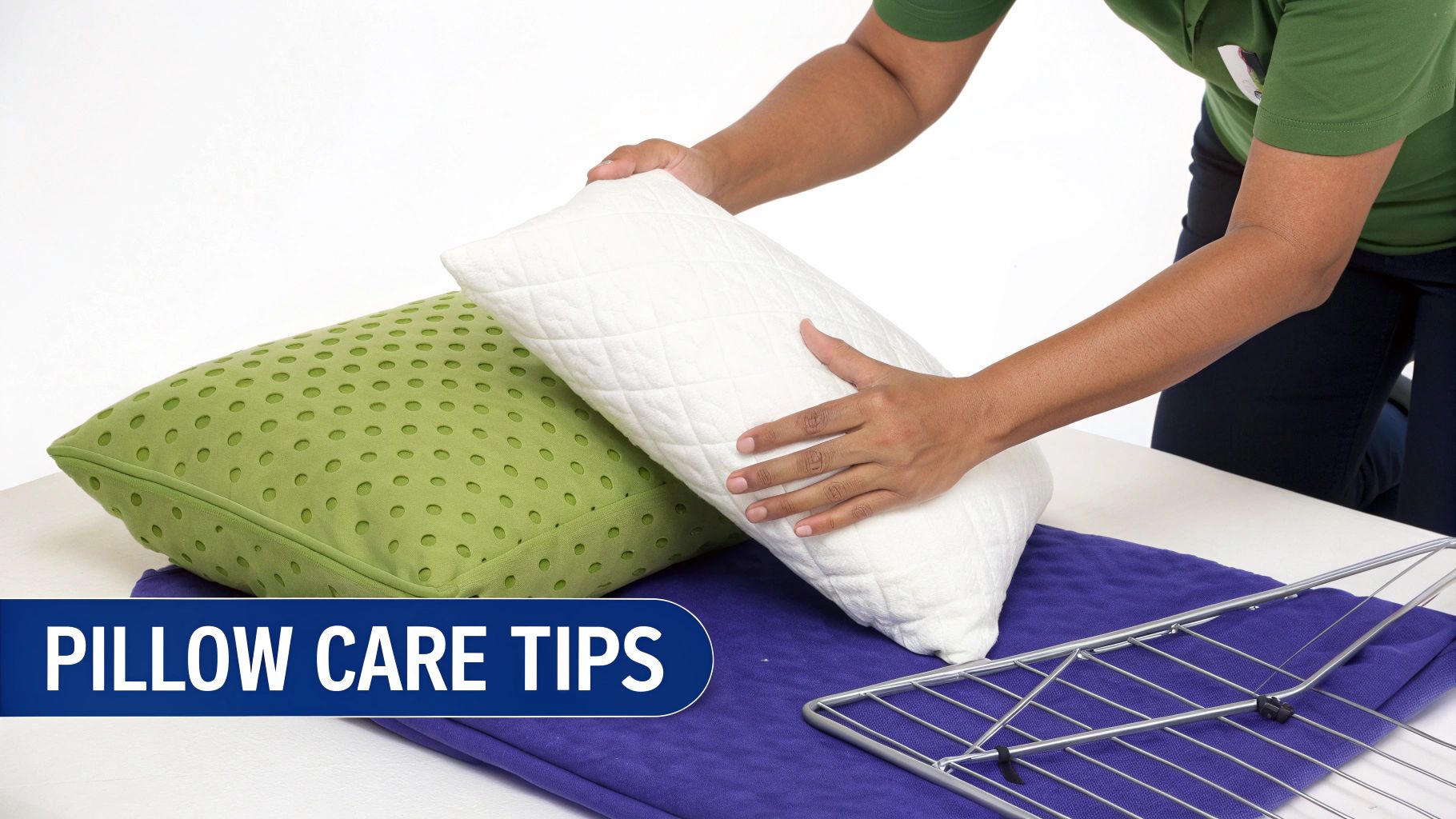Chasing that elusive perfect night's sleep? If you're tossing and turning, you’re not alone. Across the country, Kiwis are discovering that the right memory foam pillow can be the secret to finally getting some quality rest. It's a simple change, but it can make a world of difference.
The Search for a Perfect Night's Sleep in New Zealand

The hunt for better sleep is a familiar story for many of us. A rough night doesn’t just leave you feeling groggy; it can throw off your entire next day, affecting your mood, energy levels, and even your health. A great pillow is so much more than just a comfy spot for your head—it’s a vital tool for your daily wellbeing.
This guide is your practical roadmap to finding a memory foam pillow that’s just right for you. We’ll cover everything from how this unique material actually works to picking the perfect one for your sleep style and keeping it in top shape for years to come.
The Growing Demand for Quality Sleep in NZ
Lately, getting a solid night's sleep has become a serious health priority. It's no surprise that the market for memory foam pillows has been booming, as more of us Kiwis become aware of how vital good rest really is.
With some estimates suggesting that about one in five Kiwi adults struggle with ongoing sleep issues, people are actively looking for solutions that work. In fact, between 2020 and 2025, New Zealand retailers saw a whopping 30% jump in sales of memory foam pillows. This isn't just a trend; it's a national shift toward prioritising our sleep environments.
This movement shows we're starting to understand just how fundamental rest is. When you choose the right pillow, you're not just buying another item for your bedroom—you're making a conscious choice to improve your health. For more on this, check out our guide on understanding and enhancing sleep quality in New Zealand.
Investing in a high-quality memory foam pillow is one of the most direct ways to improve your sleep hygiene. It provides tailored support that can alleviate common issues like neck pain and restlessness, setting you up for a more productive and energised day.
So, let's dive in and see how this one small change can make such a big difference.
How Memory Foam Actually Cradles You to Sleep
So, what’s the big deal with memory foam? How is it so different from the traditional fluffy pillows we all grew up with?
Think of it like this: imagine pressing your hand into a piece of soft dough. It holds the perfect impression of your hand for a moment before slowly, gently returning to its original shape. Memory foam works on a similar principle, using its unique properties to give you truly personalised support.
This material, technically known as viscoelastic polyurethane foam, has two standout qualities. 'Viscous' means it moves slowly when you apply pressure, and 'elastic' means it bounces back to its original form once that pressure is gone. When you lay your head down, the foam reacts to your body heat and weight, softening just enough to mould perfectly to the unique curves of your head and neck.
This moulding action is the secret sauce. Instead of just pushing back with the same force everywhere, it spreads the weight evenly across the entire surface. This gets rid of the pressure points that often lead to a stiff neck or sore shoulders in the morning.
The Science of Personalised Support
A regular pillow just props your head up. A memory foam pillow, on the other hand, creates a custom-made cradle just for you. This personalised fit is absolutely vital for maintaining proper spinal alignment—keeping your neck in a straight, neutral line with the rest of your spine.
When your spine is properly aligned, your muscles can finally let go and fully relax. This is a game-changer for getting deeper, more restorative sleep. It’s particularly helpful for side and back sleepers, who often struggle to find a pillow that properly fills the gap between their head and shoulders without kinking their neck. It's no wonder so many Kiwis are making the switch to memory foam pillows in NZ.
The unique contouring ability of memory foam provides consistent support throughout the night. It adapts as you move, ensuring your neck and spine remain properly aligned, which can significantly reduce morning aches and pains.
Finding Your Perfect Match in NZ
It’s important to know that not all memory foam is created equal. As you begin looking around, you'll come across a few different types here in New Zealand, each tailored for different sleep styles and preferences. Getting your head around these options is the first step to choosing the right one.
Here are the main types you'll find:
- Traditional Memory Foam: This is the classic, dense foam loved for its firm support and deep, cradling feel. If you need maximum pressure relief and a pillow that stays put, this is an excellent choice.
- Gel-Infused Memory Foam: One of the old complaints about memory foam was that it could sleep a bit warm. To fix this, manufacturers started infusing the foam with cooling gel beads or swirls. This helps pull heat away from your head, giving you a much cooler night's sleep.
- Shredded Memory Foam: Instead of a solid block, these pillows are filled with small, torn pieces of foam. The best part? You can usually add or remove the filling to get the height and firmness just right for you. This makes them incredibly versatile and a fantastic option if you're not quite sure what you need.
This amazing material isn't just for pillows, of course. To see how it can benefit your entire body, check out our guide on why memory foam beds are so popular in NZ. Picking the right type is your first step towards a sleep that feels truly made for you.
Choosing the Right Memory Foam Pillow for You
Finding the perfect memory foam pillow isn't a one-size-fits-all deal. Your sleeping habits and personal comfort are what really matter, so let's get into what you need to look for to get that truly restorative night's sleep. To get it right, you need to understand two key terms: loft and density.
Think of loft as simply the pillow's height. It's the most crucial factor for keeping your spine in a nice, straight line. Density, on the other hand, is all about the feel and firmness. It determines how much support the foam gives and how quickly it springs back to its original shape after you lift your head.
Nailing the right combination of these two is the secret to waking up refreshed instead of stiff and sore. The main goal is to perfectly fill the gap between your head and the mattress, which stops your neck from bending at an unnatural angle all night.
This quick visual guide can help point you in the right direction based on what you need most from a pillow.

As you can see, narrowing down your choice can be as simple as figuring out if your priority is staying cool, getting firm support, or having the freedom to adjust the pillow yourself.
Matching Pillow Features to Your Sleep Style
To help you connect the dots between how you sleep and what you need, here's a quick reference table. It breaks down the ideal loft and density for each primary sleeping position.
| Sleeping Position | Recommended Loft (Height) | Recommended Density (Firmness) | Why It Works |
|---|---|---|---|
| Side Sleeper | High | Medium to Firm | Fills the large gap between your ear and shoulder, preventing your head from dropping down. |
| Back Sleeper | Medium | Medium | Supports the natural curve of your neck without pushing your head too far forward. |
| Stomach Sleeper | Low (or no pillow) | Soft | Minimises the upward angle of your neck, helping to keep your spine as straight and neutral as possible. |
Getting this right is everything. A pillow that’s too high or too low for your body will force your neck into a weird position for hours, which is a recipe for waking up with aches and pains. The right pillow should feel like it’s not even there—just a seamless, supportive extension of your spine.
If you’re one of the many Kiwis who sleeps on their side, it's worth taking a closer look at what works best for this position. You can learn more about finding the perfect pillow for side sleepers in our detailed guide.
Don't Forget the Pillow Cover
The foam inside is the star of the show, but the pillow cover plays a massive supporting role. It’s what you’re actually touching, and it can make a huge difference to your overall comfort, especially with New Zealand's famously changeable climate.
Look for covers made from soft, breathable materials that are good at managing moisture. Fabrics like bamboo or Tencel are brilliant choices because they help wick away heat and sweat, keeping you feeling cool and dry. A removable, machine-washable cover is also a non-negotiable for hygiene.
Get the loft, density, and cover right, and you'll have the perfect recipe for a fantastic night’s sleep.
More Than Just Comfort: The Health Benefits of a Great Pillow
A good memory foam pillow is about so much more than that initial soft, sinking feeling. While the comfort is undeniable, the real value is in what it does for your health while you’re fast asleep. Think of it as an active tool for better well-being, not just a passive headrest.
The magic is all in the support, especially when it comes to keeping your spine happy. Memory foam’s unique ability to contour to your shape helps hold your head and neck in a neutral position, perfectly aligned with the rest of your spine. This isn't just about feeling good in the moment; it's about taking the strain off your muscles and ligaments for the entire night.
If you’re one of the many Kiwis who regularly wakes up with a stiff neck, sore shoulders, or a nagging backache, this kind of alignment can make a world of difference. For a side sleeper, the right pillow perfectly fills that gap between the ear and shoulder, letting tense muscles finally relax. Back sleepers get the support they need for the natural curve of their neck, without their head being pushed uncomfortably forward. You can find more advice on this in our guide to choosing the best mattress for back pain in NZ.
An Allergy Sufferer’s Best Friend
Beyond the benefits for your joints and muscles, memory foam pillows are a breath of fresh air for allergy sufferers. The very nature of the foam—its dense structure—makes it naturally hypoallergenic. This means it’s a tough place for common nasties like dust mites, mould, and pet dander to set up shop.
This is a huge plus for anyone in New Zealand dealing with respiratory sensitivities. Traditional pillows, like those filled with feathers or down, can quickly become a haven for these microscopic irritants, leading to sniffles, sneezes, and itchy eyes that ruin a good night's rest.
A memory foam pillow creates an inhospitable environment for allergens, helping you breathe cleaner air all night long. The result? Less congestion and a far more peaceful, uninterrupted sleep.
Of course, a great pillow is just one piece of the puzzle. It's always a good idea to look into other ways of improving indoor air quality for allergy sufferers to create the best possible sleeping environment.
A Smart Investment in Your Wellbeing
Choosing a quality memory foam pillow is also a smart financial decision. Let’s face it, traditional pillows often go flat and lumpy within months, losing the very support you bought them for. High-density memory foam, on the other hand, is built to last. It’s engineered to bounce back to its original shape, night after night, year after year.
This impressive durability means you get consistent, reliable support for much longer, making it a genuinely cost-effective choice in the long run. It's a trend we're seeing across the Asia-Pacific region: people are looking for wellness products that deliver lasting value. And with New Zealand's aging population expected to hit 20% by 2030, the need for durable, orthopaedic sleep solutions is only set to increase. You can read more about pillow market trends and insights on ResearchAndMarkets.com.
Caring for Your Memory Foam Pillow to Make It Last

So, you've found a fantastic memory foam pillow and you're ready for some quality sleep. Great choice! But to make sure it delivers that cloud-like comfort for years to come, a little bit of care goes a long way. Looking after your pillow isn't just about making it last; it’s about keeping your sleep space fresh and hygienic.
When you first unbox your pillow, you might catch a faint "new foam" scent. Don't worry, this is just off-gassing—a perfectly normal and harmless process. All you need to do is take the pillow out of its packaging and let it breathe in a well-ventilated room for 24 to 48 hours. The smell will fade away on its own.
The Dos and Don'ts of Cleaning
If there's one thing to remember about memory foam, it's this: never, ever put the solid foam core in the washing machine or dryer. The intense spinning and heat will wreck the foam's delicate structure, causing it to break down and lose all its supportive magic.
Instead, keeping it clean is surprisingly simple.
- Spot-Cleaning Spills: Accidents happen. If you spill something, just act fast. Blot the spot immediately with a clean, dry cloth to soak up as much liquid as possible. For a stubborn stain, mix a tiny bit of mild detergent with water, dab it on gently, and then let it air dry completely before you even think about putting the cover back on.
- Washing the Cover: The removable cover is your first line of defence. Most are machine-washable, so just follow the instructions on the tag and pop it in the wash every month or two to keep things fresh.
A clean pillow is a cornerstone of healthy sleep. By regularly washing the cover and letting the foam core air out, you'll stop dust, skin oils, and allergens from building up.
Protecting Your Investment
Want the easiest trick in the book for keeping your pillow pristine? Use a pillow protector. It's a simple, effective barrier against sweat, spills, and dust mites, making cleaning a breeze. You can learn more about finding the right pillow protectors in NZ in our dedicated guide.
For general upkeep, you can also look into non-toxic upholstery cleaning methods that are gentle on the fabric cover. With just a little routine care, your memory foam pillow will be your trusted sleep companion for a very long time.
Where to Buy Memory Foam Pillows in New Zealand
https://www.youtube.com/embed/o0JnTAucAP0
So, you’re ready to invest in better sleep? The next step is figuring out where to look. Here in New Zealand, you’ve got quite a few options, and each has its own pros and cons. Knowing the difference will help you find the best memory foam pillows NZ retailers have on offer.
Traditionally, you’d head to a big department store or a specialist bedding shop. The great thing about shopping in person is that you can actually feel the pillow—squish it, gauge its density, and see the loft for yourself. That tactile experience can be a massive help, but the downside is that your choices might be limited to just a few major brands.
Then there's the online world, which has completely changed the game. E-commerce has thrown the doors wide open, giving Kiwis all over Aotearoa access to an incredible range of premium sleep products. Many of these come from brands that live and breathe sleep technology.
Navigating Your Purchase Options
When you’re buying online, you can't physically test the pillow. That means other things suddenly become much more important. This is where you need to put your smart shopper hat on and really read the fine print. The best online companies know this, and they build trust by taking the risk out of it for you.
Here’s what to look for, whether you’re shopping online or in a store:
- Trial Periods: Think of this as your safety net. Good brands will offer a sleep trial, usually somewhere between 30 and 120 nights. That gives you plenty of time to get used to the pillow and decide if it's truly the one for you.
- Warranties: A solid warranty, typically between 1-5 years, is a huge vote of confidence. It shows the company believes in its product and is willing to stand by its quality and durability.
- Return Policies: Always check for a straightforward, no-fuss return process. If the pillow just isn’t working out during that trial period, you should be able to send it back for a refund without any hassle.
A generous trial period is the most critical feature when buying a pillow online. It replaces the in-store 'feel' test with a real-world, risk-free experience in your own bed, ensuring your purchase is based on actual sleep quality, not a five-minute impression.
The Growing Market in Aotearoa
The appetite for quality sleep solutions just keeps growing. An interesting side note is that this trend is getting a bit of a nudge from our travel habits. As more of us use memory foam neck pillows for those long-haul flights, we get a real feel for the material's unique comfort and support. That experience often sparks curiosity about using it every night at home.
This mirrors what’s happening globally, where memory foam absolutely dominates the neck pillow market—a market valued at USD 4.69 billion in 2025. If you're interested, you can discover further insights into the neck pillow market. This growing familiarity is making it easier than ever to find excellent memory foam pillows NZ wide.
Got a Few More Questions?
Even after digging into the details, you might still have a couple of things on your mind. That's perfectly normal. Let's run through some of the most common questions we hear from Kiwis shopping for memory foam pillows in NZ, so you can feel completely confident in your choice.
How Long Will a Memory Foam Pillow Actually Last?
A well-made memory foam pillow is built to last. Unlike a standard polyester pillow that can go lumpy and flat in less than a year, a quality memory foam pillow will keep its shape and supportive feel for a solid two to three years. The key factors here are the density of the foam and, of course, how you look after it.
Don't Memory Foam Pillows Get Hot?
That’s an old reputation, and thankfully, pillow technology has moved on. While it's true that the original, dense memory foams could trap body heat, modern pillows are designed with this in mind. Today, you'll find options with cooling gel infusions, ventilation holes for airflow, or breathable covers made from materials like bamboo that actively wick away heat.
Can I Use My Electric Blanket with a Memory Foam Pillow?
It’s definitely not a good idea. The direct, sustained heat from an electric blanket can break down the sensitive viscoelastic cells in the foam. Over time, this will ruin its ability to contour and support your head, so it's best to keep them well apart to protect your pillow's lifespan.
What's This I Hear About a "Break-in" Period?
When you first unbox your pillow, it might feel a bit firmer than you expected. Don't worry, this is completely normal. It can take anywhere from a few nights to a week for the foam to soften slightly and really mould to the specific contours of your head and neck.
Think of it like breaking in a new pair of shoes. Give your body a little time to adjust to the new level of support, and soon enough, that personalised comfort will feel just right. This adjustment period is why trial periods are so important.
Ready to experience the difference a truly supportive pillow can make? Explore the expertly curated selection at New Zealand Bed Company and find the perfect foundation for a better night's sleep. https://nzbeds.co.nz

